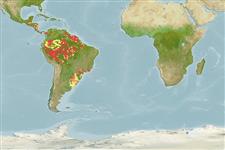Classification / Names
Common names | Synonyms | Catalog of Fishes (gen., sp.) | ITIS | CoL | WoRMS | Cloffa
Actinopterygii (ray-finned fishes) >
Cyprinodontiformes (Rivulines, killifishes and live bearers) >
Poeciliidae (Poeciliids) > Poeciliinae
Etymology: Poecilia: Greek, poikilos = with a lot of colours (Ref. 45335). More on author: Bloch, Schneider.
Environment / Climate / Range
Ecology
Freshwater; brackish; benthopelagic; pH range: 7.0 - 8.2; dH range: 10 - 40; non-migratory. Tropical; 26°C - 28°C (Ref. 2060), preferred ?
America: between Suriname and Brazil (not the Atlantic area South of the Laguna dos
Patos basin in Brazil); introduced to the Caribbean.
Size / Weight / Age
Maturity: Lm ? range ? - ? cm
Max length : 7.8 cm TL male/unsexed; (Ref. 111953); common length : 3.8 cm SL male/unsexed; (Ref. 26728); max. published weight: 6.48 g (Ref. 111953)
Short description
Morphology | Morphometrics
Widespread in mildly brackish water in canals and drainage ditches at the edges of swamps, but rarely found in freshwater. Feeds on mosquito larvae and has at times been used for control in ponds and reservoirs (Ref. 35237).
Life cycle and mating behavior
Maturity | Reproduction | Spawning | Eggs | Fecundity | Larvae
Males are very active and also approach the females of other Poecilinae. [Females produce 6 - 10 offspring which follow their mother for a few hours after birth, referring to Ref. 35237.] After 28 days gestation, female gives birth to 100 young or more. Sexual maturity is reached after 3-4 months (Ref. 2060).
Kenny, J.S., 1995. Views from the bridge: a memoir on the freshwater fishes of Trinidad. Julian S. Kenny, Maracas, St. Joseph, Trinidad and Tobago. 98 p. (Ref. 11225)
IUCN Red List Status (Ref. 115185)
CITES (Ref. 94142)
Not Evaluated
Threat to humans
Harmless
Human uses
Fisheries: of no interest
More information
ReferencesAquacultureAquaculture profileStrainsGeneticsAllele frequenciesHeritabilityDiseasesProcessingMass conversion
Tools
Special reports
Download XML
Internet sources
